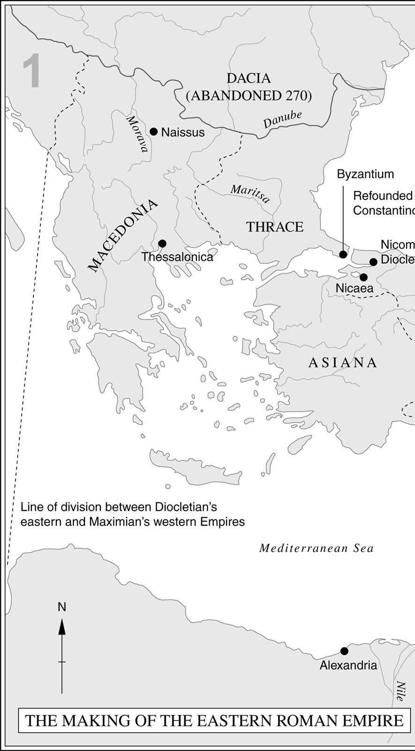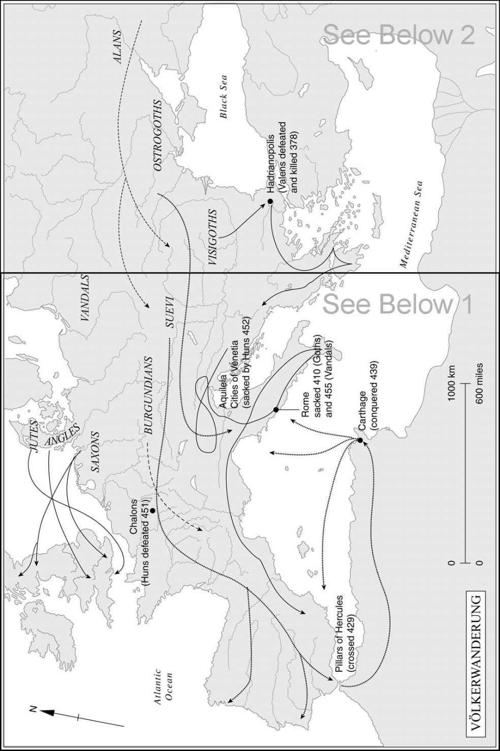The New Penguin History of the World (56 page)
Read The New Penguin History of the World Online
Authors: J. M. Roberts,Odd Arne Westad
One explanation is cumulative: the state apparatus in the West gradually seized up after the recovery of the fourth century. The whole concern became too big for the demographic, fiscal and economic base which carried it. The main purpose of raising revenue was to pay for the military machine, but it became more and more difficult to raise enough. There were no more conquests after Dacia to bring in new tribute. Soon the measures adopted to squeeze out more taxes drove rich and poor alike to devices for avoiding them. The effect was to make agricultural estates rely more and more upon meeting their own needs and becoming self-supporting, rather than producing for the market. Parallel with this went a crumbling of urban government as trade languished and the rich withdrew to the countryside.
The military result was an army recruited from inferior material, because better could not be paid for. Even the reform of dividing it into mobile and garrison forces had its defects, for the first lost their fighting spirit by being stationed at the imperial residence and becoming used to the pam-pering and privileges that went with city postings, while the second turned into settled colonists, unwilling to take risks which would jeopardize their homesteads. Another descent in the unending spiral of decline logically followed. A weaker army drove the empire to rely still more on the very barbarians the army was supposed to keep at bay. As they had to be recruited as mercenaries, soothing and conciliatory politics were needed to keep them sweet. This led the Romans to concede more to the barbarians just when the pressure of the Germanic folk-movements was reaching a new climax. Migration and the attractive prospect of paid service with the empire probably counted for much more in the barbarian contribution to imperial collapse than the simple desire for loot. The prospect of booty might animate a raiding-party but could hardly bring down an empire.



At the beginning of the fourth century Germanic peoples were stretched along the whole length of the frontier from the Rhine to the Black Sea, but it was in the south that the most formidable concentration was at that moment assembled. These were the Gothic peoples, Ostrogoth and
Visigoth, who waited beyond the Danube. Some of them were already Christian, though in the Arian form. Together with Vandals, Burgundians and Lombards, they made up an east Germanic group. To the north were the west Germans: Franks, Alamanni, Saxons, Frisians and Thuringians. They would move into action in the second phase of the
Völkerwanderung
of the fourth and fifth centuries.
The crisis began in the last quarter of the fourth century. The pressure of the Huns, a formidable nomadic people from central Asia, on barbarians further west was mounting after 370. They overran the Ostrogothic territory, defeated the Alans and then turned on the Visigoths near the Dniester. Unable to hold them, the Visigoths fled for refuge to the empire. In 376 they were allowed to cross the Danube to settle within the frontier. This was a new departure. Earlier barbarian incursions had been driven out or absorbed. Roman ways had attracted barbarian rulers and their followers had joined Rome’s army. The Visigoths, though, came as a people, perhaps 40,000 strong, keeping their own laws and religion and remaining a compact unit. The Emperor Valens intended to disarm them; it was not done and instead there was fighting. At the battle of Adrianople in 378 the emperor was killed and a Roman army defeated by the Visigoth cavalry. The Visigoths ravaged Thrace.
This was in more than one way a turning-point. Now whole tribes began to be enrolled as confederates –
foederati
, a word first used in 406 – and entered Roman territory to serve against other barbarians under their own chiefs. A temporary settlement with the Visigoths could not be maintained. The eastern empire was helpless to protect its European territories outside Constantinople, though when the Visigothic armies moved north towards Italy early in the fifth century, they were checked for a while by a Vandal general. By now the defence of Italy, the old heart of the empire, was entirely dependent on barbarian auxiliaries and soon even this was not enough; Constantinople might be held, but in 410 the Goths sacked Rome. After an abortive move to the south, with a view to pillaging Africa as they had pillaged Italy, the Visigoths again turned north, crossed the Alps into Gaul and eventually settled as the new kingdom of Toulouse in 419, a Gothic state within the empire, where a Gothic aristocracy shared its overlordship with the old Gallo-Roman landlords.
These are confused events, difficult to follow, but there is still one other major movement of peoples which has to be noticed in order to explain the fifth-century remaking of the European racial and cultural map. In return for their settlement in Aquitania, the western emperor had succeeded in getting the Visigoths to promise that they would help him to clear Spain of other barbarians. Of these the most important were the Vandals. In
406 the Rhine frontier, denuded of soldiers sent to defend Italy against the Visigoths, had given way too and the Vandals and Alans had broken into Gaul. From there they made their way southwards, sacking and looting as they went and crossing the Pyrenees to establish a Vandal state in Spain. Twenty years later they were tempted to Africa by a dissident Roman governor who wanted their help. Visigoth attacks encouraged them to leave Spain. By 439 they had taken Carthage. The Vandal kingdom of Africa now had a naval base. They were to stay there for nearly a century, and in 455 they, too, crossed to sack Rome and leave their name to history as a synonym for mindless destructiveness. Terrible as this was, it was less important than the seizure of Africa, the mortal blow to the old western empire. It had now lost much of its economic base. Though great efforts could and would still be made in the West by eastern emperors, Roman rule there was on its last legs. Even in 402, the western emperor and the Senate had already fled from Rome to Ravenna, the last imperial capital in Italy. The dependence on barbarian against barbarian was a fatal handicap. The cumulative impact of fresh pressure made recovery impossible. The protection of Italy had meant abandoning Gaul and Spain to the Vandals; their invasion of Africa had meant the loss of Rome’s grain-growing provinces.
The collapse was completed in Europe in the third quarter of the century. It followed the greatest of the Hun assaults. These nomads had followed the Germanic tribes into the Balkans and central Europe after a preliminary diversion to ravage Anatolia and Syria. By 440 the Huns were led by Attila, under whom their power was at its height. From Hungary, where the great steppe corridor of Asia peters out, he drove west for the last time with a huge army of allies, but was defeated near Troyes in 451 by a ‘Roman’ army of Visigoths under a commander of barbarian origin. This was the end of the Hun threat; Attila died two years later, apparently scheming to marry the western emperor’s sister and perhaps become emperor himself. A great revolt the following year by the Huns’ subjects in Hungary finally broke them and they are thenceforth almost lost to sight. In Asia, their home, new confederations of nomads were forming to play a similar part in the future, but their story can wait.
The Huns had all but delivered the
coup de grâce
in the West; one emperor had sent the pope to intercede with Attila. The last western emperor was deposed by a Germanic warlord, Odoacer, in 476 and formal sovereignty passed to the eastern emperors. Though Italy, like the rest of the former western provinces, was henceforth a barbarian kingdom, independent in all but name, Italians regarded the emperor as their sovereign, resident in Constantinople though he might be.
The structure which had finally given way under these blows has in its last decades something of the Cheshire cat about it. It was fading away all the time; it is not particularly meaningful to pick one date rather than another as its end. It is unlikely that 476 seemed especially remarkable to contemporaries. The barbarian kingdoms were only a logical development of the reliance upon barbarian troops for the field army and their settlement as
foederati
within the frontiers. The barbarians themselves usually wanted no more, unless it was simple loot. Certainly they did not plan to replace imperial authority with their own. It is a Goth who is reported saying, ‘I hope to go down to posterity as the restorer of Rome, since it is not possible that I should be its supplanter.’ Other dangers were greater and more fundamental than barbarian swagger.
Socially and economically, the tale of the third century had been resumed in the fifth. Cities decayed and population fell. The civil service slid deeper into disorder as officials sought to protect themselves against inflation by taking payment for carrying out their duties. Though revenue declined as provinces were lost, the sale of offices somehow kept up the lavish expenditure of the court. But independence of action was gone. From being emperors whose power rested on their armies, the last emperors of the West declined through the stage of being the equals in negotiation with barbarian warlords whom they had to placate, to being their puppets, cooped up in the last imperial capital, Ravenna. Contemporaries had been right in this sense to see the sack of Rome in 410 as the end of an age, for then it was revealed that the empire could no longer preserve the very heart of
romanitas
. By then, there had been many other signs, too, of what was going on. The last emperor of Constantine’s house had tried during a brief reign (361–3) to restore the pagan cults; this had earned him historical fame (or, in Christian eyes, infamy) and, revealingly, the title ‘the Apostate’, but he was not successful. Believing that a restoration of the old sacrifices would ensure the return of prosperity, he had too little time to test the proposition. What is now perhaps more striking is the unquestioned assumption that religion and public life were inseparably intertwined, on which his policy was based and which commanded general agreement; it was an assumption whose origins were Roman, not Christian. Julian did not threaten Constantine’s work and Theodosius, the last ruler of a united empire, at last forbade the public worship of the ancient gods in 380.
What this meant in practice is hard to say. In Egypt it seems to have been the final landmark in the process of overcoming the ancient civilization which had been going on for eight centuries or so. The victory of Greek ideas first won by the philosophers of Alexandria was now confirmed by the Christian clergy. The priests of the ancient cults were to be harried as pagans. Roman paganism found outspoken defenders still in the fifth century and only at the end of it were pagan teachers expelled from the universities at Athens and Constantinople. None the less a great turning-point had been reached; in principle the closed Christian society of the Middle Ages was now in existence.
